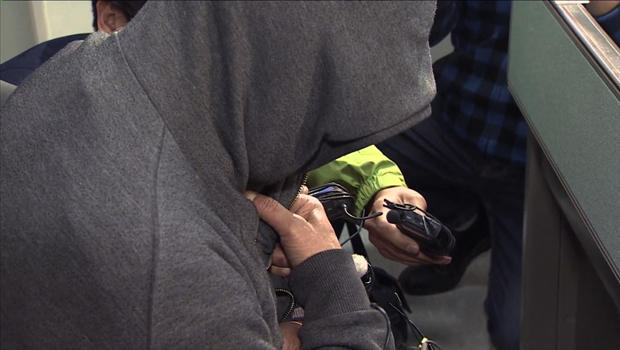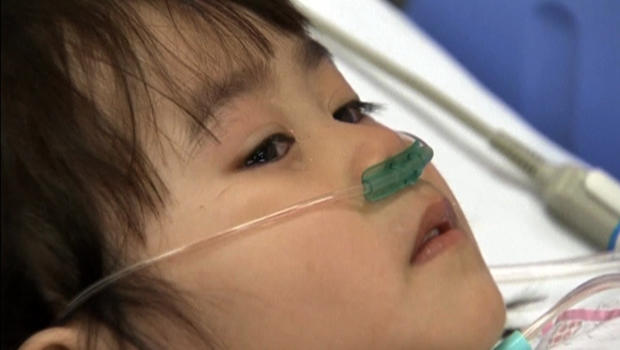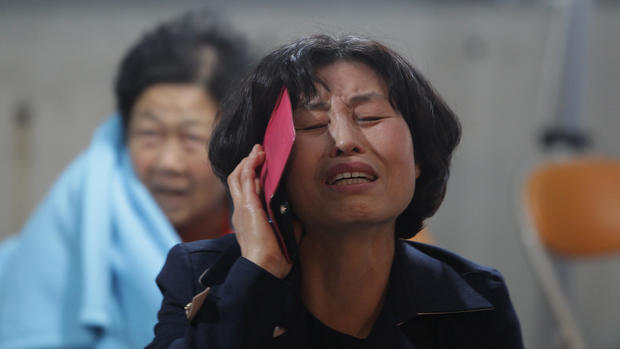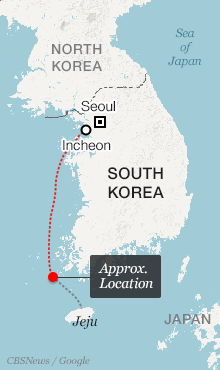South Korean ferry captain faces criminal investigation into when he left ship
MOKPO, South Korea -- The captain of the ferry that sank off South Korea's southern coast, likely with scores of people trapped inside, is facing a criminal investigation into whether he may have been among the first off the ship.
The captain of the Sawol, identified by broadcaster YTN and the Yonhap news agency as 69-year-old Lee Joon-seok, was questioned by the coast guard and made a brief, videotaped appearance, although his face was hidden by a gray hoodie.
"I am really sorry and deeply ashamed," Lee said. "I don't know what to say."
The confirmed death toll from Wednesday's sinking of the Sawol off southern South Korea was 25, the coast guard said. But the number was expected to rise with about 270 people missing, many of them high school students on a class trip. Officials said there were 179 survivors.
One of the only bright spots was when a 6-year-old was plucked from the ferry. Her parents and brother remain missing.
Kim Han-sik, president of Chonghaejin Marine Co., the ship's owner, also apologized separately, bowing deeply and saying through his tears, "I committed a sin punishable by death. ... I am at a loss for words. I am sorry. I am sorry."
On Thursday, a crewman described chaos and confusion on the bridge of the ferry, saying the captain first tried to stabilize the vessel after it started to list before ordering its evacuation.
By the time the order came, however, the crewman said it had become impossible to help many of the passengers. In addition to the captain, a dozen crew members survived.
Divers worked in shifts to try to get into the sunken vessel, but strong currents would not allow them to enter, said coast guard spokesman Kim Jae-in. Rescuers hammered on the hull of the capsized ferry hoping for a response, but none came.
Divers began pumping oxygen into the ship on Friday morning, the coast guard said. It wasn't immediately clear whether the oxygen was to help possible survivors or part of a salvage operation.
The water temperature in the area was about 54 degrees Fahrenheit, cold enough to cause signs of hypothermia after about 90 minutes of exposure.
The coast guard spokesman said three vessels with cranes are being brought in to help with the rescue and to salvage the ferry, which sank not far from the southern city of Mokpo and now sits with just part of its keel visible.
The first instructions from the captain were for the passengers to put on life jackets and stay put, and it was not until about 30 minutes later that he ordered an evacuation, Oh Yong-seok, a 58-year-old crew member, told The Associated Press. But Oh said he wasn't sure if the captain's order, given to crew members, was actually relayed to passengers on the public address system.
Some passengers said they were told to stay on board and wait for help. A cellphone video shown to CBS News appears to show a group of passengers inside the ferry wearing life vests and waiting for help. The loss of that precious time may have deprived many passengers of the opportunity to escape.
In Washington, President Barack Obama called the sinking a "terrible tragedy" and offered his condolences.
"As one of our closest allies, our commitment to South Korea is unwavering in good times and in bad, and that's something I'll underscore during my visit to Seoul next week," Obama said at a news briefing on Thursday afternoon.
Video obtained by AP that was shot by a survivor, truck driver Kim Dong-soo, shows the vessel listing severely as people in life jackets cling to the side of the ship to keep from sliding. A loudspeaker announcement can be heard telling passengers to stay in their quarters.
There were 475 people aboard, including 325 students on a school trip to the tourist island of Jeju in the south of the country. The 480-foot ferry had traveled overnight for the14-hour journey from Incheon on the northwestern coast of South Korea, and was three hours short of its destination when the ship began to list.
The cause is not yet known.
South Korean media said it was possible the cargo - about 1,000 tons - was not tied down properly and may have shifted suddenly, causing the ship to tilt dangerously.
Oh, a helmsmen on the ferry with 10 years' shipping experience, said that when the crew gathered on the bridge and sent a distress call the ship was already listing more than 5 degrees, the critical angle at which the ship can be brought back to even keel.At about that time, a third mate reported that the ship could not be righted, and the captain ordered another attempt, which also failed, Oh said. A crew member tried to reach a lifeboat but tripped. The captain then ordered the evacuation.
Passenger Koo Bon-hee, 36, told the AP that many people were trapped inside by windows that were too hard to break. He wanted to escape earlier but an announcement said passengers should stay put.
"The rescue wasn't done well. We were wearing life jackets. We had time," Koo, who was on a business trip to Jeju with a co-worker, said from a hospital bed in Mokpo where he was treated for minor injuries. "If people had jumped into the water ... they could have been rescued. But we were told not to go out."
It is not clear whether the captain's actions violated any procedures, and he may have believed at the time that it was still possible to control the vessel, which would have made the order to evacuate unnecessary.
Worried and angry parents of the students gathered at Danwon High School in Ansan, which is near Seoul, while other relatives assembled on Jindo, an island near where the ferry slipped beneath the surface, leaving only the blue-tipped, forward edge of the keel visible.
In Mokpo, relatives of the dead students wailed and sobbed as ambulances drove away with the bodies, headed to Ansan. The families, who spent a mostly sleepless night at the Mokpo hospital, followed the ambulances in their cars. At the school, some desperate relatives lashed out in frustration, screaming threats at journalists. On Jindo Island, also near the accident site, one woman passed out and was carried to an ambulance.
The family of one of the dead, 24-year-old teacher Choi Hye-jung, spoke about a young woman who loved to boast of how her students would come to her office and give her hugs.
"She was very active and wanted to be a good leader," her father, Choi Jae-kyu, 53, said at Mokpo Jung-Ang Hospital while waiting for the arrival of his daughter's body. Choi's mother, sitting on a bench at the hospital, sobbed quietly with her head bent down on her knee.
The last major ferry disaster in South Korea was in 1993, when 292 people were killed.



